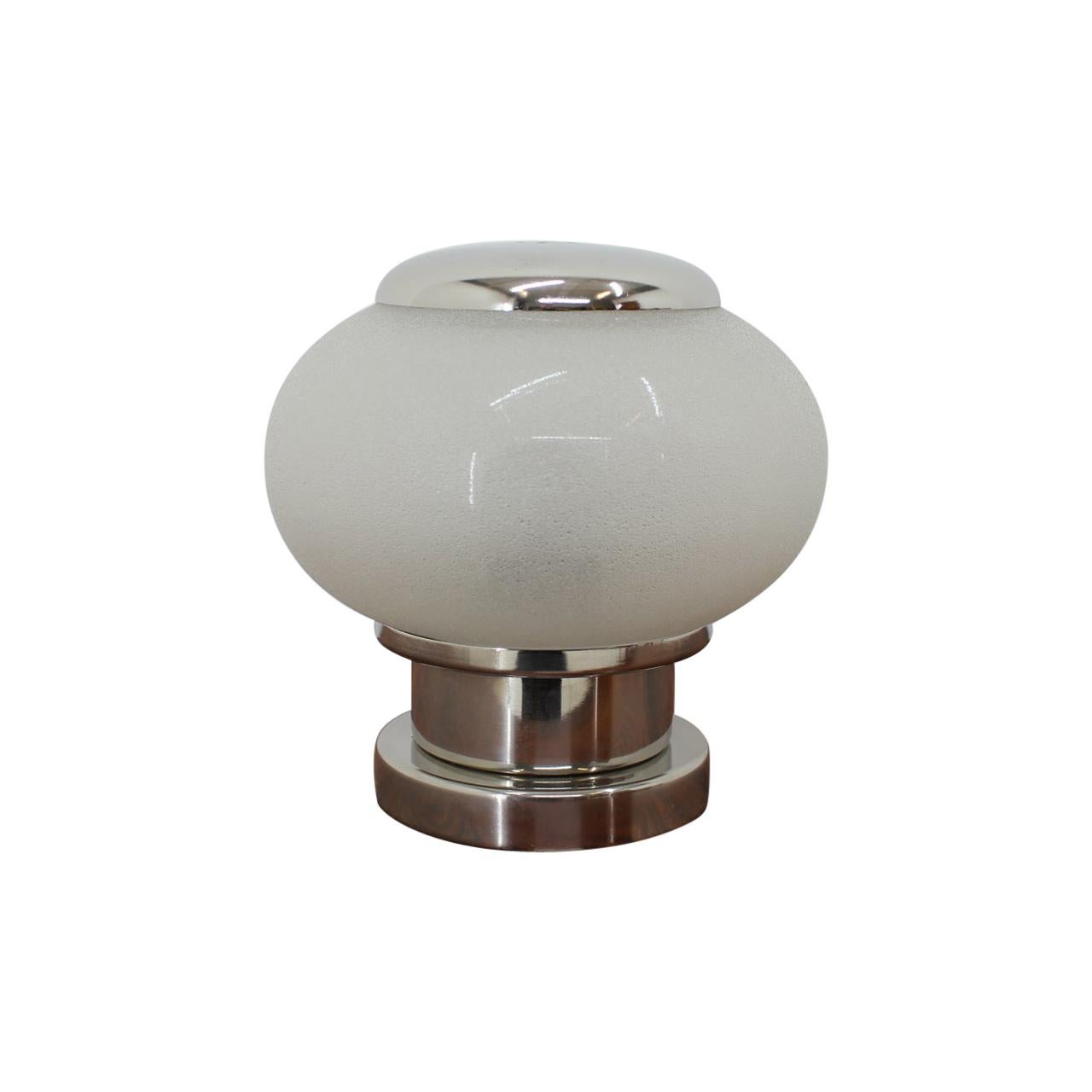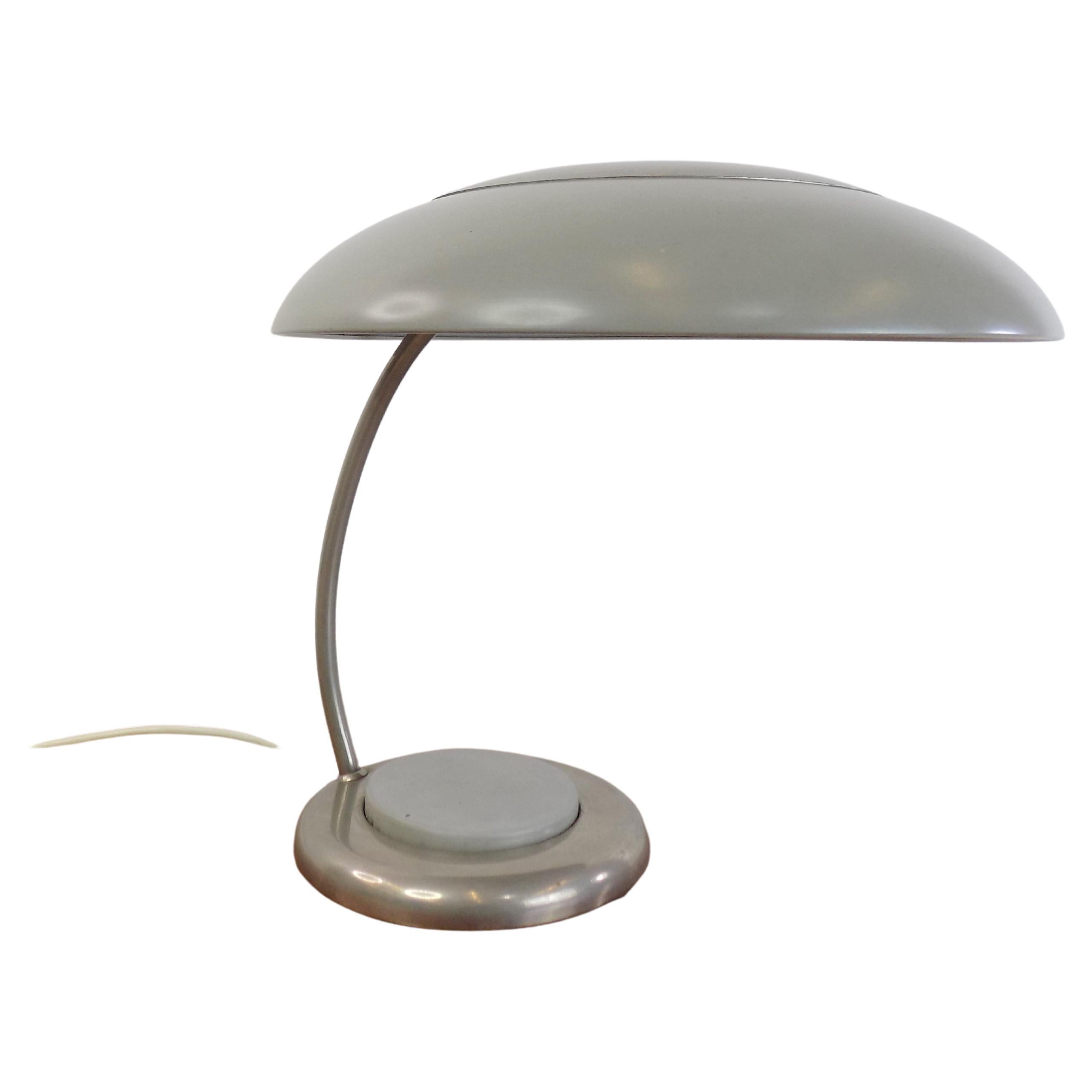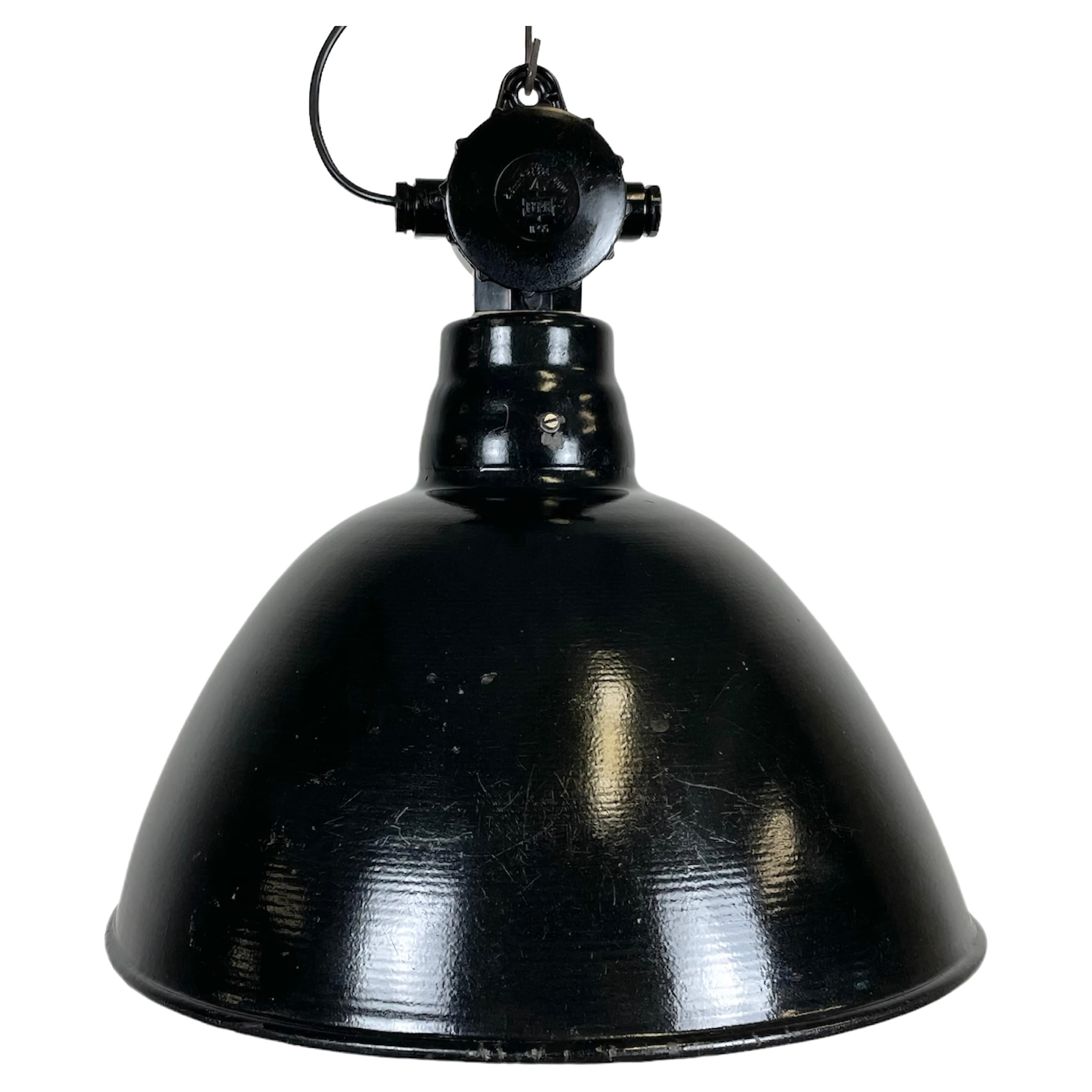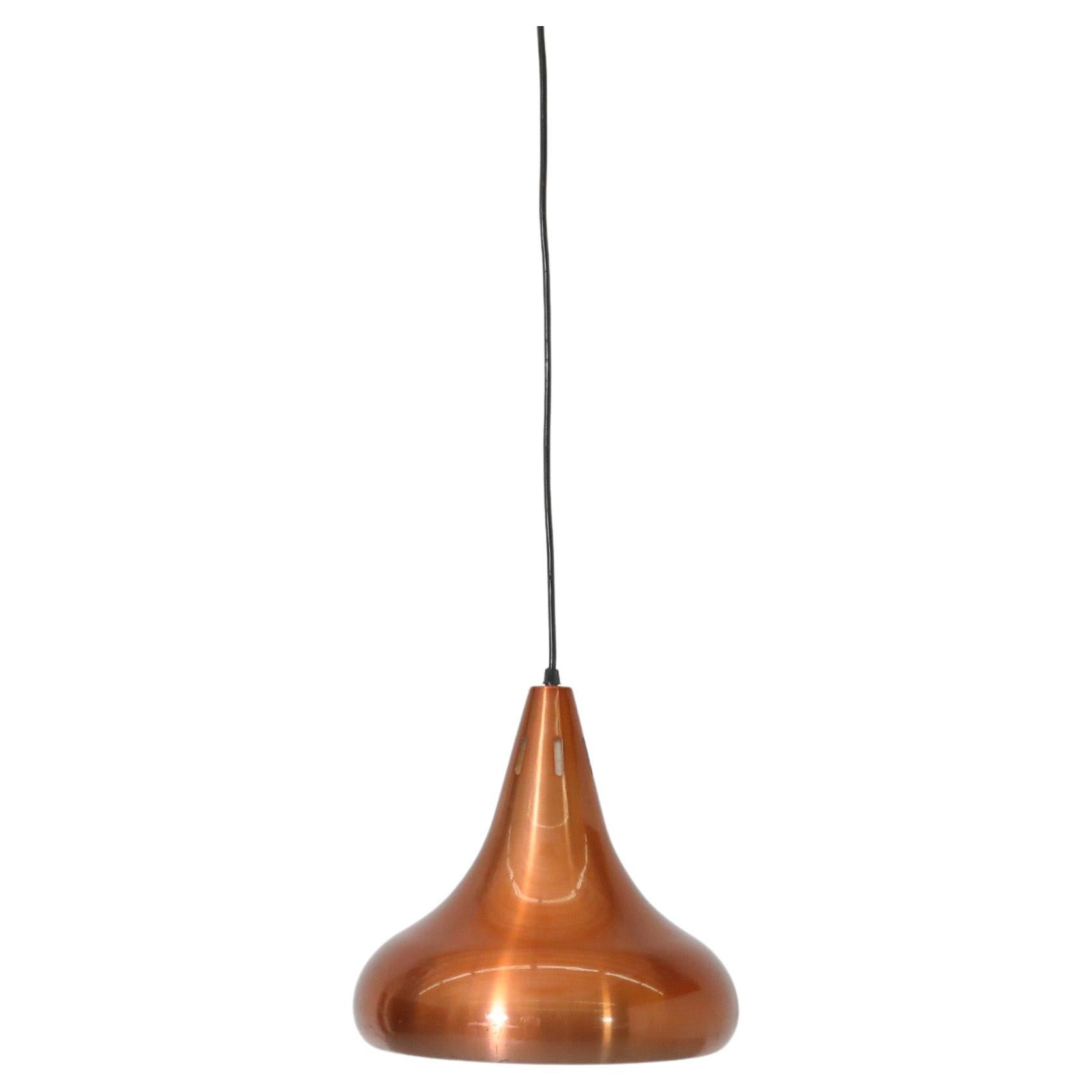Items Similar to VEB Leuchtenbau Model "7204" Table Lamp, Germany 1950s
Want more images or videos?
Request additional images or videos from the seller
1 of 6
VEB Leuchtenbau Model "7204" Table Lamp, Germany 1950s
About the Item
The "7204" lamp designed in the late 1950s at VEB Leuchtenbau is a classic example of mid-20th-century German design and craftsmanship. Manufactured by VEB Leuchtenbau, a company that was once a prominent player in the lighting industry in East Germany during the post-war era, this table lamp reflects the distinctive design aesthetics of the 1950s.
Materials played a crucial role in the design of this lamp. The round white painted iron base provides stability and complements the overall mid-century colour palette. The inclusion of the original manufacturer sticker on the bottom of the base adds a touch of authenticity and historical value. Inside the base, a cast iron counterweight ensures that the lamp remains stable and well-balanced. The design is generally attributed to Rudolf Lutz.
The central feature of the lamp is the conical tube, perforated with elongated slots. This not only adds to the lamp's aesthetic appeal but also serves a functional purpose, allowing soft, diffused light to emanate from the lampshade. The round iron mushroom-style lampshade, painted in a stylish red colour, adds a bold contrast to the white body and base, representing the vibrant and eclectic colour choices typical of the 1950s.
An ornamental brass finial on top of the lampshade exemplifies the attention to detail and the combination of materials that were characteristic of the era. This blending of metal, iron, and brass showcases the versatility and creativity of mid-century German design.
In the 1950s, German design was heavily influenced by the principles of Bauhaus and mid-century modernism. This era was marked by a commitment to functionalism, minimalism, and innovative use of materials. The "7204" VEB Leuchtenbau Table Lamp encapsulates these principles, offering not only practical illumination but also an iconic piece of design that beautifully captures the spirit of the time.
The Polish company Stołeczne Zakłady produced a table lamp in this style, but the differences are big enough not to be confused with this lamp.
This lamp is not just a source of light; it is a time capsule that preserves the design essence of post-war Germany and the creative spirit of an era that revolutionized design worldwide. With its blend of form and function, it remains a symbol of the enduring appeal of mid-century modern design.
- Creator:VEB Leuchten (Manufacturer)
- Dimensions:Height: 10.24 in (26 cm)Diameter: 13.78 in (35 cm)
- Power Source:Plug-in
- Voltage:110-150v
- Lampshade:Included
- Style:Mid-Century Modern (Of the Period)
- Materials and Techniques:
- Place of Origin:
- Period:
- Date of Manufacture:1950s
- Condition:Wear consistent with age and use.
- Seller Location:Budapest, HU
- Reference Number:1stDibs: LU9486237561452
About the Seller
New to 1stDibs
Joined in the past six months.
No Reviews Yet
Vetted Seller
These experienced sellers undergo a comprehensive evaluation by our team of in-house experts.
1stDibs seller since 2023
- ShippingRetrieving quote...Ships From: Budapest, Hungary
- Return PolicyA return for this item may be initiated within 14 days of delivery.
More From This SellerView All
- European Mid-Century Wooden Stools with Hand-Carved Scoop Seats, Europe ca 1950sLocated in Budapest, HUThe design of this European stool is characterized by a minimal, clean approach that seeks to combine functionality with beauty. Its focus is on simple lines and light spaces, devoid...Category
Mid-20th Century European Folk Art Stools
MaterialsWood
- Space Age Red "Tulip" Swivel Chairs by Péter Ghyczy, Germany 1970sBy Peter GhyczyLocated in Budapest, HUSpace Age design chairs made of fiberglass resin. They were made in limited quantities. Design by Hungarian designer, Péter Ghyczy. The chairs still feature the prestigious jury label of the Ipaművészeti Vállalat! Jury number: 120107 THese so-called tulip chairs pop with Mid-Century Modern style and a bright red color. The comfortable bodies sit upon wide, bell-shaped pedestal bases, making these chairs unique and stylish additions to any setting. Peter Ghyczy was born into an aristocratic family in Budapest. He was a student at the Pannonhalmi Bencés High School from 1954, but in 1956 his family left Hungary. In 1960, he began studying architecture at the Technical University of Aachen. In 1961, he became an assistant to German architecture professor Rudolf Steiner. Later, he got a job at the plastic research institute. As part of a UNESCO project, he also visited Egypt, where he worked to save ancient ruins. He graduated from the university in 1967 and wrote his thesis on unusual school buildings. He became a German citizen in 1969. Peter Ghyczy is one of the most important 20th Hungarian century designers who, as an immigrant - like Henry van de Velde, Breuer Marcel...Category
Vintage 1970s German Space Age Swivel Chairs
MaterialsResin, Fiberglass
- Søren Georg Jensen Teak Coffee Table for Kubus, Denmark 1960sBy Søren Georg JensenLocated in Budapest, HUThis Danish mid-century modern teak coffee table was designed by the Danish designer, Søren Georg Jensen and produced by Kubus. The design is sculpturally distinctive with intertwini...Category
Vintage 1960s Danish Mid-Century Modern Coffee and Cocktail Tables
MaterialsTeak
- Danish Cabinetmaker Triangular Coffee Table With Tapered Tripod Legs, Denmark caLocated in Budapest, HUassociate Danish furniture design with the country’s golden age, the mid-twentieth century. This simple, yet beautifully designed and executed side table shows why this is. This mid...Category
Vintage 1960s Danish Mid-Century Modern Side Tables
MaterialsWood
- Lívia Gorka Decorative Ceramic Bowl, Hungary ca 1960sBy Livia GorkaLocated in Budapest, HUMunkácsy Mihály Prize-winning Hungarian ceramicist, worthy artist, and daughter of Géza Gorka, Gorka Lívia is one of the most renowned Hungarian ceramists. Her present work is a highly distinctive piece even if measured against her own exceptional repertoire. In 1947, Lívia Gorka passed her master's exam in pottery. Her master was his father, Géza Gorka. As an independent, self-employed artist, se worked in the Gorka workshop in Verőce until 1959, and had created in her own studio after that. The source of her art has always been nature, and as such, her typical objects (if we can discuss typical at all in her case) are large, asymmetrical vessels, idols, fish, birds, and stones. Gorka preferred creating unique objects and to think in series and groups of objects. She worked with high-fired, custom-made materials such as stone, oxide clay glazes, and often combined clay with metal. The colours of her works have a strong plastic effect and are generally quite restrained. This handmade piece reflects her minimalistic and timeless language of forms that appears in every inch of this bowl that is in the field between art, design, and handicraft. The colours are spectacular, the black glazed outside harbours a medley of shapes and colours on the inside. This glazed, geometrically decorated piece has an unusual, modern shape with a hollow opening on top. The bright orange line traces the shape to the hollow opening towards the top and articulates the unusual angle at which the bowl stands. Lívia Gorka was able to step out of her father's shadow and create her own style with her ceramics. A true artist who always worked with craft techniques, she also developed her own technique for making the glaze, so her works, like this bowl, always represent a recognizable, unique world of shapes and colours. Gorka was a master of these subtleties that established her one-of-a-kind visual language that is still coveted not just in her native Hungary, but all around the world among ceramic enthusiasts and collectors. Thanks to this, it can easily be placed in both a vintage or contemporary interior and is sure to stand out from its surroundings. About the designer: Gorka Lívia (Nógrádverőce March 5, 1925 – Diszel, August 4, 2011) Mihály Munkácsy Prize-winning Hungarian ceramicist, a distinguished artist. Daughter of Géza Gorka. She was born in Nógrádverőce to Géza Gorka and Irén Kovács. She received her professional and artistic training in her father's workshop. She got used to serious work when he was six or eight years old, as she worked in his father's workshop during school breaks...Category
Vintage 1960s Hungarian Mid-Century Modern Ceramics
MaterialsCeramic
- Adrian Pearsall "2315-C" Lounge Chairs for Craft Associates, USA 1960sBy Adrian PearsallLocated in Budapest, HUAdrian Pearsall was born in 1925 in Trumansburg, New York. Like many Mid-Century Modern artists of the time, Pearsall was a graduate of architecture school. This background is profou...Category
Vintage 1960s American Mid-Century Modern Lounge Chairs
MaterialsBouclé, Wood
You May Also Like
- German Table Lamp, VEB Narva Leuchtenbau Lengefeld, 1979By VEB NarvaLocated in Praha, CZ- Made in Germany - Made of metal, glass - Re-polished - Fully functional - Good, original condition.Category
Vintage 1970s German Mid-Century Modern Table Lamps
MaterialsMetal
- Bauhaus Table Lamp from Veb Leuchtenbau LengefeldLocated in Ludwigslust, DEThe table lamp is in very good condition with an attractive patina. The dominant lampshade made of greyish metal and a chrome cover shows minimal signs of wear, as well as the lamp base which impresses with the extraordinarily large round switch. The electronics work perfectly. This classic design of a Bauhaus lamp comes from the 1960s by VEB Leuchtenbau...Category
Vintage 1960s German Mid-Century Modern Table Lamps
MaterialsMetal
- East German Black Enamel Factory Light by Lbd Veb Leuchtenbau Dresden, 1950sBy VEB LeuchtenLocated in Kojetice, CZIndustrial enamel factory light made by Lbd Veb Leuchtenbau Dresden in East Germany during the 1950s.It features black enamel shade with white enamel i...Category
Mid-20th Century German Industrial Chandeliers and Pendants
MaterialsEnamel, Iron
- German Vintage Table Lamp from VEB Leuchten, 1970sBy VEB LeuchtenLocated in Praha, CZVintage Space Age metal and plastic table lamp made in the 1970s in Leipzig (Germany).Category
Mid-20th Century Czech Space Age Table Lamps
MaterialsMetal
- VEB Leuchtenbau Copper Drop PendantBy Tom Dixon, VEB LeuchtenLocated in Los Angeles, CAMid-Century East German copper drop ceiling pendant by VEB Leuchtenbau, 1970s. 'VEB' or Volks Eigener Betrieb translates to Publicly-owned business and was the main legal form of ind...Category
Vintage 1970s German Mid-Century Modern Chandeliers and Pendants
MaterialsCopper
- German Model 1115 Table Lamp Marianne Brandt for Kandem Leuchtenbau LeipzigBy Marianne Brandt, KandemLocated in NUEMBRECHT, NRWThis model 1115 dark grey Bauhaus table lamp is based on an early design by Marianne Brandt for Kandem and features a glass foot as well as a lacquered bakelite shade. It was manufac...Category
Vintage 1930s German Bauhaus Table Lamps
MaterialsGlass, Bakelite
Recently Viewed
View AllMore Ways To Browse
Cast Mushroom
Mid Century Brass Mushroom Lamp
Rectangular Chrome Lamp
Pair Barovier Murano Glass Lamps
Modern Metal Table Lamp With Nice Shade
Blue And White Porcelain Lamp Base
Wireless Light
Antique French Ormolu Lamps
Clamp On Light
Rectangular Bronze Table Lamp
Enterance Hall Furniture
French Small Metal Lamp
Oc White Desk Lamp
Vintage Italian Figurine Lamps
Lindner Lidded Jar
Peono Lamp
Charlie Pottery
Double Bankers Lamp





